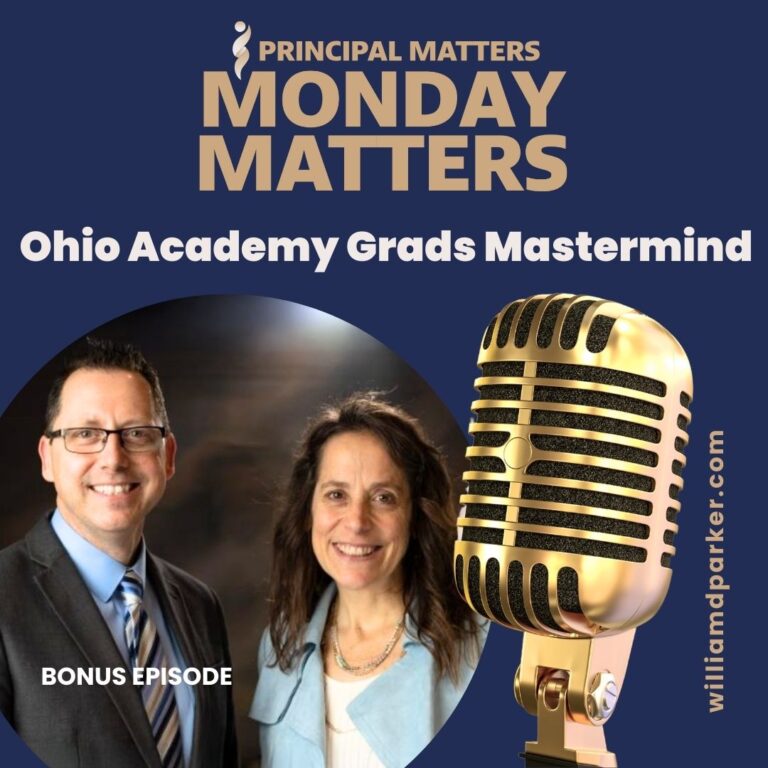Podcast: Play in new window | Download
When I was a boy, I loved to walk the garden where my grandparents grew summer vegetables.

My grandfather had an interesting way of planting tomatoes. He would dig a deep hole, scatter a small handful of fertilizer in the bottom of the hole, and then place a tomato plant in while gathering the rich soil around the plant till it was secure. Then he’d water the plant and place a bucket over it. He would alternate times when the plants were covered or open to the sun until they were well established and ready to start blossoming.
Creating a strong environment for learning involves a lot of care and attention. In addition to being instructional leaders, school leaders have to be aware of how we are cultivating the soil of our schools. Sometimes this requires consistently managing various demands, dealing with difficult conversations, and planting seeds of positive school culture.
This past week I hosted a webinar for principals over chapters 6-8 of Principal Matters: The Motivation, Courage, Action and Teamwork Needed for School Leaders. In this conversation, I want to give a few tips and thoughts that may help keep these challenges in perspective.
If you have time to listen to the podcast version of the webinar, you will hear these points with examples. Here are some takeaways that may be helpful as you think about your own work in school leadership:
Part 1: Managing Demands
As you walk through a school, you will find teachers, students, and staff rely on you for more than just supervision or observation. People are looking for problem-solvers. In my first year as an administrator, I carried a notepad with me and tried to write down notes on every conversation I was having for follow-up.
I soon discovered I was spending more time do follow-up than I was helping others find their own solutions. In some ways, I was fishing for them rather than teaching them to fish. With that in mind, here are four takeaways to keep in mind when managing questions or demands:
1. Give up your “Savior” complex. (It takes a team to lead a school.)
2. Share follow-up. (If it’s important, have them write it down.)
3. Teach others to find solutions. (Learn to “shift the monkey” as Todd Whitaker teaches.)
4. Set timers for time consuming tasks. (Your value does not equal an empty inbox. Sometimes mundane tasks like emails or reports can go faster as timed tasks.)
You cannot lead alone. And the sooner you realize you need a team, the better. It is easy for leaders to fall into the trap of believing their job is to save the day. That kind of mentality will lead to burnout. Instead, shift your mindset so that you approach the complex problems of your school with the idea that it will take everyone on your team to find solutions, create strong environments, and reach new goals.
Part 2: Dealing with Difficult People
It’s easy to remember hard conversations—especially ones where people lose it emotionally. No one ever learns to perfectly manage difficult conversation. But there are some ways you can shift your mindset so you learn to better manage them. Here are six tips to keep in mind:
1. Make sure you’re not the difficult one.
2. Seek to understand before being understood
3. Be firm but friendly.
4. Change your posture and use humor when appropriate.
5. Agree to disagree.
6. Consider bringing parties to the table.
Keep in mind that others want to be heard and understood. Sometimes the goal is not finding complete agreement as it is being a sounding board and helping find solutions together. Simple things go a long way in deescalating emotional conversations: like keeping your hands open when you talk, taking notes to show you are listening well, and repeating back what you hear someone saying. At the end of the day, you want to know you’ve given others the courtesy you would want if the tables were turned.
Part 3: Showing Appreciation and Maintaining Morale
It is easy to lose sight of the culture and morale of your team members when you’re focused on managing demands or difficult moments. I talk to a lot of principals who ask what they can do to keep their team members encouraged. Here are eight suggestions on ways to embed appreciation into your routines:
1. “Kudos” emails (These are quick summaries of great things you see happening when you do a walkthrough of your building.)
2. Video shares (Use your smart-phone to capture great learning moments and share via email, social media or link in a newsletter.)
3. Hand-written notes or cards (All of enjoy the thoughtfulness of a handwritten thought or word. I once had a 25-year veteran teacher who told me she had never received a hand-written note of encouragement from an admin till I gave her one.)
4. Monthly awards (Use your faculty or team meetings to highlight great team players once a month and publish it out to others.)
5. Newsletter/website publicity (Have a frequent, consistent summary of communication for parents and community members; use it as a way to brag on your teachers, students, and staff.)
6. Face-to-face (Take advantage of observation follow-ups to look a teacher in the eyes and tell them something specific you appreciate about what they do with students.)
7. Food, food, and more food (Maybe it’s because I love to eat, but I always feel encouraged and loved when someone adds food to a meeting.)
8. Social media shares (Never before have we had access to so many free, accesibile ways to share and brag about our teachers and schools. Whether it is Facebook, Twitter, Instagram, LindedIn, or Voxer: find ways to celebrate and encourage others.)
Let’s Wrap This Up
Because my grandparents were serious about gardening, we enjoyed lots of fresh green beans, tomatoes, or cucumbers when I was a boy. And what couldn’t be eaten fresh was canned or pickled for future use. I can still picture my grandad eating an entire sliced tomato with crackers and pimento cheese for a mid-day meal. The produce he enjoyed didn’t happen by chance. It was the result of years of gardening that involved learning, problem solving, and developing the best soil.
As school leaders, we are directly involved in the kind of environment where learning can happen. How we manage demands, deal with difficulties, and encourage positive moments will lend to the outcomes others have in our learning environments. Don’t think you will ever do this with perfection. By sharing tasks with teammates, learning to navigate tough conversations, and highlighting successes of others, you will find yourself cultivating the soil for positive outcomes for your teachers and students.
Now It’s Your Turn
What tips or suggestions would you add to managing demands, dealing with difficult conversations, or celebrating successes? Think of one step you can take today to keep the positive momentum going with your teachers or team.
Sign-Up For Free Updates and Ebook
When you enter your email address below, you will automatically receive my newest posts and a free Ebook, 8 Hats: Essential Roles for School Leaders. Let’s keep learning together!
Subscribe for free weekly updates and receive free e-book!
(function($) {window.fnames = new Array(); window.ftypes = new Array();fnames[0]=’EMAIL’;ftypes[0]=’email’;fnames[1]=’FNAME’;ftypes[1]=’text’;fnames[2]=’LNAME’;ftypes[2]=’text’;}(jQuery));var $mcj = jQuery.noConflict(true);
Principal Matters–The Book!

School leaders are very busy, so each of the twenty-four chapters is designed as a quick-read and followed with take-action questions for follow-up or reflection. If you want practical ideas on understanding your purpose, managing school teams, dealing with challenges, and leading with courage, action, motivation, and teamwork, go HERE to pick up a copy for you or your team.
Messaging Matters

Harness the power of messaging to create a culture of acknowledgment, respect, and celebration. Written specially for leaders, this title is divided into three parts, helping readers to maximize their role as chief communicators with students, teachers, and parents and community. Each chapter includes suggestions for using digital tools to enhance messaging and ends with reflection questions and practical next steps.


